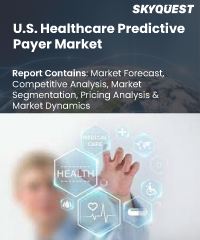
Report ID: SQMIG35G2272

Report ID:
SQMIG35G2272 |
Region:
Country |
Published Date: February, 2024
Pages:
224
|
Tables:
117 |
Figures:
77
Our industry expert will work with you to provide you with customized data in a short amount of time.
REQUEST FREE CUSTOMIZATIONUS Healthcare Predictive Payer Market size was valued at USD 2.62 billion in 2019 and is poised to grow from USD 3.9 billion in 2023 to USD 19.4 billion by 2031, growing at a CAGR of 22.1% in the forecast period (2024-2031).
us healthcare predictive payer market players are focusing on innovating advanced solutions which could help organizations plan their financial budgets efficiently, avoid improper payments & frauds, and effectively assess risk. Healthcare payers comprise insurance companies and health plan sponsors (employers and unions) and they use analytical solutions to expand their business, improve healthcare services, and quality and minimize administrative costs. The increase in the adoption of healthcare analytics across the industry vertical has been the primary factor responsible for the growth of the market. Ease of data understanding, as well as better outcomes, have also contributed significantly to market growth. The market is witnessing a surge in demand for advanced payer analytics owing to the growing healthcare costs and the need for organizations to devise strategies to curb expenditure. 'UnitedHealth Group', 'Anthem', 'Aetna', 'Cigna', 'Humana', 'Blue Cross Blue Shield Association', 'Kaiser Permanente', 'Centene Corporation', 'Molina Healthcare', 'WellCare Health Plans', 'Health Net', 'CareSource', 'Buckeye Health Plan', 'Superior HealthPlan', 'AultCare', 'SummaCare', 'Paramount Health Care', 'SelectHealth', 'Providence Health Plan', 'Geisinger Health Plan'
Growing demand for cost effective and early treatment applications is expected to spur the overall us healthcare predictive payer market statistics as the adoption of big data in healthcare assists researchers to perform population health data analysis and helps limiting the potential risks of epidemics, treat diseases while lowering the overall costs associated with it. Such big data can include patients’ medical records, information collected by healthcare testing equipment, hospital records, prescription information, family medical history, personal ID as well as insurance details, among others. Doctors and medical professionals use big data analysis to make efficient decisions regarding treatment and services. Thus, it helps doctors to identify illness/disease at early stage which can be treated early and costs less. Such aforementioned factors are expected to boost the adoption rate of healthcare analytics.
Rising insurance enrolments, increasing healthcare frauds, rising cost of healthcare, and in-house shortage of skilled personnel. However, factors like rising incidences of data breach & loss of confidentiality, unforeseen costs associated with outsourcing along with the loss of managerial control in outsourced projects are expected to restrain the growth of the healthcare payer services market. Due to an increase in the use of big data in healthcare organizations to address risks connected with numerous chronic diseases, the healthcare analytics market is predicted to grow. Furthermore, the growing use of telemedicine solutions by various enterprises to lower operational costs and improve service quality is propelling the healthcare analytics market expansion. Furthermore, big data facilitates the preservation of critical patient data that may be used to improve a company’s healthcare outcomes. It reduces personnel expenses and increased organizational productivity, all of which help the healthcare analytics market to grow during the forecast period.
The digital advancements in the healthcare field, and the digitization of records, are the key factors driving the growth of the us healthcare predictive payer market. Adoption of such technologies is on an upward trend thus propelling the market. Digital data is being used to derive meaningful results, cost reduction, and minimize fraudulent insurance claims. The U.S. government has been increasingly spending on healthcare and focusing on improving digital infrastructure, which is boosting technological advancements in the field. Due to technological advancements, decision-making for payers and healthcare providers has become easier with the help of analytical tools. The overall increase in healthcare expenditure has amounted to more than USD 4 trillion in the year 2020. It is not only helping the healthcare industry develop faster but has also made healthcare more affordable and precise. The healthcare analytical tools are helping administrators and policymakers in determining in turn saving billions of dollars per year. Doctors’ analytical tools have helped to determine the best treatment plans for a particular patient by studying and analysing their history.
Want to customize this report? This report can be personalized according to your needs. Our analysts and industry experts will work directly with you to understand your requirements and provide you with customized data in a short amount of time. We offer $1000 worth of FREE customization at the time of purchase.

Report ID: SQMIG35G2272